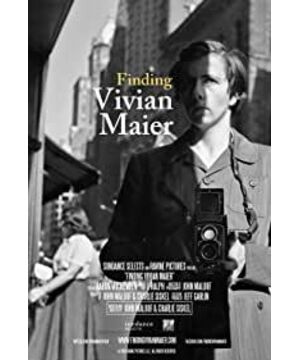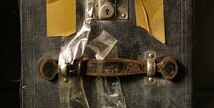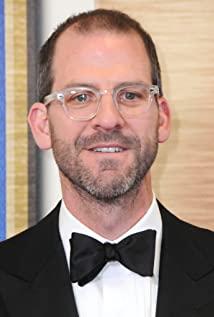There is such a woman who is unmarried and has no children.
Before his death, he was full of talent, but he was a nanny for 40 years in obscurity.
After his death, he left behind 150,000 negatives and was recognized by the photography world as one of the greatest photographers of the 20th century.
She's a nanny and a legendary photographer—
Vivian Maier
Vivian Maier
In the impression of most people, artists are destined to be a group of people who are deviant and shocking the world.
But there are always exceptions, and there are always people who deliberately hide their talents.
On the surface, he is engaged in a humble and ordinary occupation, not seeking fame and fortune, but silently immersing himself in his hobbies.
When the rivers of the years have washed away, what is deposited is the crystallization of their lifelong creations.
Vivian is such a hermit who pursues photography her whole life.
Vivian's life situation is very reminiscent of the movie "Sister Peach".
They are both unmarried and childless, and have been a nanny for a lifetime.
The difference is that Sister Tao devoted her life to the family she took care of.
However, Vivian used her identity as a nanny to hide her other side as a photographer.
Vivienne balances her role as a nanny with that of a photographer: the former to make ends meet, the latter to nourish the soul.
She deliberately misspelled her name, imitated a crappy French accent, and jokingly referred to herself as a "spy".
She hid all her negatives in a suitcase and never showed her work to anyone around her.
So that people who knew her were surprised to hear that she could take pictures.
Vivian's life trajectory is very similar to that of Van Gogh: unknown in life, famous after death.
However, unlike Van Gogh's underappreciated talent, Vivian voluntarily kept a low profile.
She did not intend to rely on her talents to gain fame and fortune, she just likes photography, which is more like a "self-healing".
This indifference to fame and fortune is rare, and one cannot help but want to know more about this mysterious woman.
The documentary "Finding Vivian Maier" takes us to explore the double life of "nanny photographer" Vivian Maier.
The film was nominated for Best Documentary at the 68th BAFTA and Best Documentary at the 87th Academy Awards.
Vivian's work would hardly be known to the world if it wasn't for an accidental discovery.
After all, even the most familiar people around her don't know the secret of her photography skills.
In the summer of 2007, John Maloof, 29, paid $380 at an auction for a box containing 40,000 negatives to collect information for a book on Chicago's architectural history.
Most of these negatives are images of the streets of Chicago in the 1950s and 1970s. No matter the composition, light and shadow, or dynamic and uniqueness, they are all at a high level.
This intrigued Maloof.
John Maloof set up a website for her, Vivianmaier, and uploaded about 200 photos.
Unexpectedly, the photo immediately became popular on the Internet and received countless likes and comments.
People are amazed at these street works shot in the 1950s.
Maloof went on to buy more auction items from the owner of the negatives, this time including:
Hundreds of thousands of negatives and slides, thousands of undeveloped rolls of film, and countless receipts, letters, clippings, and notes.
But only there is no information about the owners of these things.
When Maloof began to browse the negatives, he found that the photos, taken haphazardly on the streets of Chicago, revealed a rustic and moving power.
They record the old days of the past and the history of the city's development.
As a result of Maloof's arrangement, her work began to appear in newspapers in the United States, as well as in Italy, Argentina and the United Kingdom.
In 2010, Vivian's work began to be exhibited in Chicago, becoming a hotly debated figure in the photography circle and recognized as one of the most important contemporary street photographers in the United States.
Lots of unprocessed film, had it not been discovered by Malouf, might have been permanently tucked away in the corners.
He couldn't help but wonder who took these photos and why? Why don't you show people?
Is this a reporter? Or a professional photographer?
So, Maloof began a journey to find the mysterious photographer.
But when he tried to search the Internet for the name that appeared on the photo tape, all he got was an obituary.
Maloof called one of Vivian's belongings, who said, "That's my babysitter."
This surprised Maloof, why would a nanny take these pictures?
Driven by curiosity, Maloof begins to visit Vivian's past employers, hoping to find out more about her.
But the mysterious Vivian did not leave too many clues for the world, and most people gave her similar evaluations:
A conscientious nanny, liked by children, somewhat withdrawn and very private.
Every time she entered a house, Vivienne asked to lock the door of the nanny's room.
And asked for their verbal assurance that no one would be allowed into her room under any circumstances.
And she rarely tells people her real name, often using alternate spellings or outright pseudonyms, such as "V. Smith" she once called herself.
Vivienne Meyer was born in New York in 1926 and returned to France (her mother's hometown) shortly after birth to spend her childhood in a small village.
In 1951, 25-year-old Vivian Maier returned to New York.
In 1959, she left New York and moved to Chicago, and since then has mostly made a living as a nanny.
What impressed her former employers was that Vivian always carried a lot of heavy suitcases every time she moved into a family.
Now they know that those suitcases are filled with negative film taken over the years.
Everyone doesn't understand-
Why aren't these photos washed out by Vivienne?
What's the point of filming if no one is watching?
Cleaning floors, preparing meals, and babysitting are all Vivienne's day jobs.
She likes children, is good to children, and children like her.
Contradictory, bold, mysterious, eccentric, very private... that's what acquaintances say about Vivian.
After seeing her works, people can't help but feel that her status as a maid is a bit wronged by this talented photographer.
But Vivian didn't seem to think so.
Vivienne worked as a seamstress in a sweatshop when she first arrived in New York, but she quickly discovered that the job wasn't for her.
Hard work is second, mainly because there is no time to take pictures.
She found that babysitting was the best job for her.
There is food and accommodation, and I can play with the children. I have a lot of free time to walk and shoot on the streets, and the toilet in the nanny’s room can just be used as a darkroom.
On Vivian's days off, she often wanders into "ghetto" places in the city to shoot.
Marginalized people are the subjects of Vivienne Maier's photography , including the poor, the elderly, minorities and children.
According to the memories of the children Vivian took care of, in the early summer, Vivian often pushed the stroller and hung her precious Rollei camera around her neck, stealing some "adventure routes" that her employers would not let her take.
If you strolled through the affluent part of Chicago in the 1950s, you might have seen this tall, serious-looking woman walking with a child or two.
With her ear-length hair cut short and in a loose-fitting men's shirt that doesn't reveal her body, she looks like most nannies.
The only difference: she often wears a Rollei camera around her neck.
Most of the people in Vivienne's photos are taken upside down, which means the camera is positioned very low, which adds a bit of stalwart and humor to her characters.
The reason is that this Rollei camera has a unique way of framing, which allows Vivian to look down and shoot.
This also avoids looking directly at the subject, making it less uncomfortable to shoot.
This is Vivian's way: I'm filming you, but you better not know.
This can't help but think of the "photographers" I often meet on the street now, holding up the lens and taking pictures of strangers.
In contrast, Vivian's way is more polite.
Vivian's subjects are not only daily life on the streets, she is almost the earliest photojournalist, recording the changes of the times with her lens.
The fifties were casual suburban living, the sixties were big social changes, and the seventies were deep upheaval.
Her shots have traveled almost every corner of the city.
As a veteran movie fan, Vivian also chases stars.
She often wanders around the cinema with her camera, and many stars have been photographed by her.
In Chicago, Vivian was employed by the Janes Burgers family for seventeen years.
She almost became another mother to three boys in the family.
She shot home videos of them, engraved those warm moments, and it was obvious that Vivian must love them.
In the last years of her life, Vivien became increasingly withdrawn and eccentric, frequenting places like garbage collection stations and park benches.
Sometimes she gets so drunk that people think she's homeless, but she actually has $21,000 in the bank.
People thought she was just an ordinary old woman, but in fact, in the five storage bins, she hid her artistic life recorded with the camera lens.
Afterwards, the three brothers of Janes Burges' family helped her into a nursing home and took turns to take care of her, which is completely the story of American Peach.
At that time, Vivienne was already a little delirious. She forgot what she had stored in the storage bin and forgot to pay, so she had the auction at the beginning of the article and the windfall of John Maloof.
Today, people are finally starting to realize this buried genius.
Vivienne's works are not only reproduced in the sun, but also exhibited all over the world, and have been praised by all walks of life.
The New York Times said in a report:
One of the more prominent American street photographers has been unearthed and praised for her images "capturing the fragrance of the city and the paradoxical moments that give it its jazzy flavor", arguing that Vivian's relationship with Harry Kara Han (Harry Callahan) is a master photographer.
The Independent argues that Vivian's work is most attractive to those "on the side of the successful and wealthy Americans of the 1950s and 1960s: children, black maids, groveling beggars on store porches" .
The director of the Chicago Cultural Center, who held an exhibition for Vivian, praised her work as "like a photographic history book".
"I owe Vivian a devout and persistent effort — she was one of the greatest photographers of her time," Maloof said.
"The more I got to know Vivien, the more fascinated I became. She was a bizarre person, smart and talented. I got it and wanted to share it with the world."
We should thank John Maloof for discovering Vivienne's work, and it was his compilation and dissemination that made the world aware of this remarkable photographer.
Vivian Maier's hermit life has made her works never commercialized, which also makes these photographic works have a unique artistic appeal.
Vivienne makes us understand that there is no lack of beauty and fun in daily life, but only a pair of eyes to discover.
Vivienne balances her role as a nanny with that of a photographer: the former to make ends meet, the latter to nourish the soul.
As both a nanny and a talented photographer, she used 150,000 negatives to prove to the world—
Whatever your career is, do it as long as it interests you.
Live the life you love, time will tell.
*The author of this article: RAMA
View more about Finding Vivian Maier reviews









